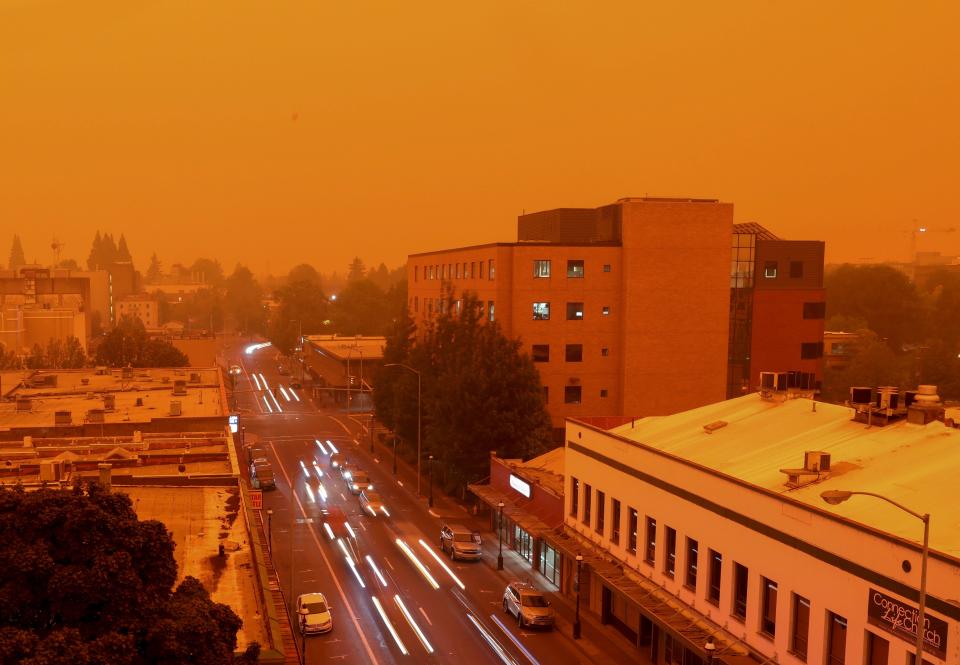'Unhealthy air' days increasing in Oregon as wildfire season lengthens
Wildfire smoke impacts are increasing across Oregon, and broke at least one record last year, a new study from the state Department of Environmental Quality shows.
Last year’s wildfire season was less intense than in 2020, but was longer, the study reported. The result, in many communities, was more days of poor air quality.
That’s a trend that’s been growing. The state’s wildfire season historically started in late July and ended in early September. Now, fires have been starting in mid-July, and lasting until early October.

Last year, most of the smoke impacts were in eastern and southern Oregon, starting with the Bootleg fire northeast of Klamath Falls, the report found.
In Bend last year, there were 18 days when the air was unhealthy for sensitive groups or worse, setting a new record.
In Klamath Falls, there were 38 days when the air was unhealthy for sensitive groups, tying a record set in 2018.
The Portland metro area and Willamette Valley largely escaped smoky conditions last year.
Last year, Salem had no days with poor air quality.
The city didn’t have any days that were “unhealthy for sensitive groups” or worse until 2014, when it had one. That increased to two days in 2015, two in 2017, and four in 2018. In 2020 it recorded 11 days, including seven that were considered “hazardous.”
DEQ’s yearly report tracks wildfire-related air quality trends in 24 Oregon communities, using data from the Air Quality Index.
The index measures levels of fine particulate matter, or PM 2.5, the primary pollutant in wildfire smoke. It categorizes air quality, from best to worst, as good, moderate, unhealthy for sensitive groups, unhealthy, very unhealthy and hazardous.
The report calls the number of days in the in the four worst groups “unhealthy air quality days.”
The report shows that air quality has been worsening since 2012, with more frequent days categorized as unhealthy or worse.
“If these trends continue, Oregon would see an increase in unhealthy air quality conditions during wildfire season, and more summers with widespread air quality impacts,” the report reads. “Additionally, summers with little or no wildfire smoke, like 2016 and 2019, will be much less commonplace.”
How to stay safe
Wildfire smoke contains a wide variety of pollutants, including particulate matter (PM2.5 and PM10), black carbon, nitrogen dioxide, carbon monoxide, volatile organic compounds, polycyclic aromatic hydrocarbons and metals.
According to the Oregon Health Authority, PM2.5, which are the smallest particles, may represent the greatest health concern because the particles can be inhaled deeply into the lungs and may even reach the bloodstream.
OHA offers recommendations for staying safe during smoke events:
Pay attention to local air quality reports. Listen and watch for news or health warnings about smoke. Also pay attention to public health messages about taking additional safety measures.
Refer to visibility guides if they are available.
If you are advised to stay indoors, keep indoor air as clean as possible. Keep windows and doors closed unless it is extremely hot outside. Run an air conditioner if you have one, but keep the fresh air intake closed and the filter clean to prevent outdoor smoke from getting inside. Running a high efficiency particulate air (HEPA) filter or an electro-static precipitator (ESP) can also help you keep your indoor air clean. If you do not have an air conditioner and it is too warm to stay inside with the windows closed, seek shelter elsewhere.
When smoke levels are high, do not use anything that burns, such as candles, fireplaces, or gas stoves. Do not vacuum, because vacuuming stirs up particles already inside your home. Do not smoke, because smoking puts even more pollution into the air.
Do not rely on masks for protection. Paper "comfort" or "dust" masks commonly found at hardware stores are designed to trap large particles, such as sawdust. These masks will not protect your lungs from smoke. There are specially designed air filters worn on the face called respirators. These must be fitted, tested and properly worn to protect against wildfire smoke. People who do not properly wear their respirator may gain a false sense of security. If you choose to wear a respirator, select an “N95” respirator, and make sure you find someone who has been trained to help you select the right size, test the seal and teach you how to use it. It may offer some protection if used correctly.
Tracy Loew is a reporter at the Statesman Journal. She can be reached at tloew@statesmanjournal.com, 503-399-6779 or on Twitter at @Tracy_Loew.
This article originally appeared on Salem Statesman Journal: 'Unhealthy air' days increasing in Oregon as wildfire season lengthens

